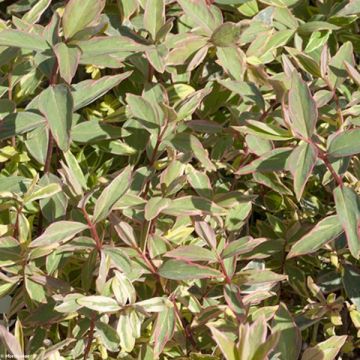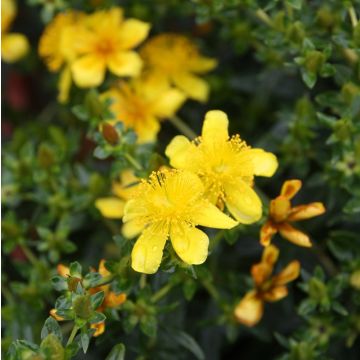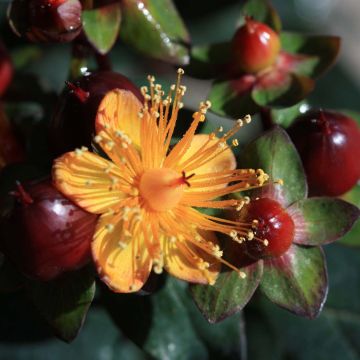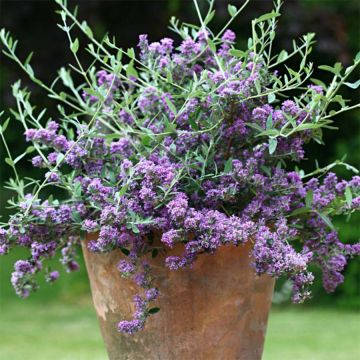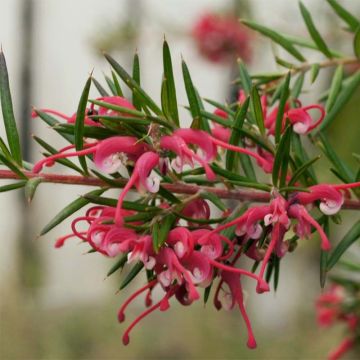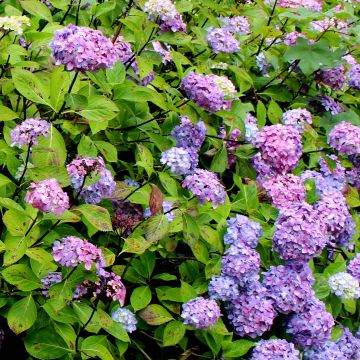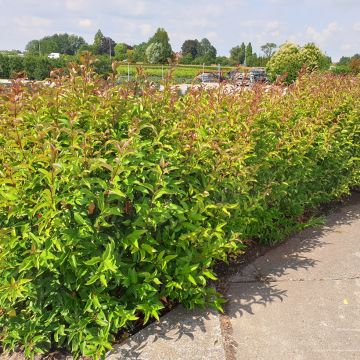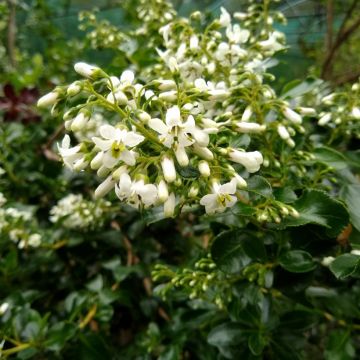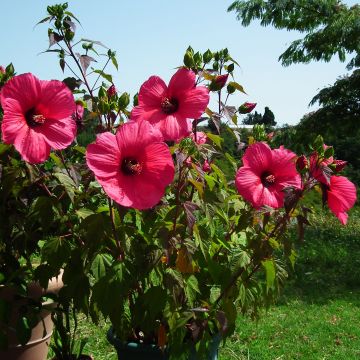

Hypericum x moserianum - St. John's wort


Hypericum x moserianum - St. John's wort
Hypericum x moserianum - St. John's wort
Hypericum x moserianum
St. John's wort
Moderate shoot
Bernard , 10/09/2024
This item cannot be shipped to the selected country
Delivery charge from €5.90
More information
Schedule delivery date,
and select date in basket
This plant carries a 24 months recovery warranty
More information
We guarantee the quality of our plants for a full growing cycle, and will replace at our expense any plant that fails to recover under normal climatic and planting conditions.
From €5.90 for pickup delivery and €6.90 for home delivery
Express home delivery from €8.90.

Does this plant fit my garden?
Set up your Plantfit profile →
Description
Hypericum x moserianum was obtained in the 1890s by Jean Jacques Moser, a horticulturist in Versailles. Less well-known than its variegated foliage cultivar 'Tricolor', it is, however, much hardier than the latter and has no specific requirements. Not very tall but clad in dense foliage that persists in winter in mild climates, it develops reddish-tinged and slightly arched stems that give it a lovely languid habit. It provides a long flowering period from July to October, in successive waves, in the form of cup-shaped flowers of a vibrant golden yellow punctuated with red stamens. A hardy, drought-resistant, ornamental, and floriferous plant, which will undoubtedly find its place in the garden.
Hypericum x moserianum is the result of a hybridisation between Hypericum patulum, a non-hardy and Chinese bush, and H. calycinum, a pretty much indestructible floriferous pest native to Turkey. It belongs to the Hypericaceae family. This relatively fast-growing shrub typically reaches a height of 50 to 60cm (20 to 24in) and a width of 60 to 70cm (24 to 7in), sometimes less depending on growing conditions. It has a bushy and rounded, rather sprawling habit, carried by flexible stems that are reddish to purplish in colour. They are adorned with entire, semi-evergreen leaves, which are evergreen in mild climates. The elongated leaves measure 5cm (2in), are pointed, leathery, and of a beautiful slightly bluish green. It practically flowers for four months of the year, from June-July to September-October, with a break during the hottest weeks. The flowers are produced abundantly at the tips of the branches. They are solitary or grouped in small clusters of 2 to 5. They measure 6cm (2in) in diameter and are composed of 5 rounded, bright golden yellow petals arranged in an open cup shape. The centre of the flower is occupied by a crown of protruding, long red anthers. This flowering is followed by the formation of a few conical fruits that are red and turn blue when ripe.
St. John's worts are appreciated for their very long flowering period and their real ease of cultivation in all types of soil and in all climates, even by the seaside. If you like yellow flowers, Hypericum x moserianum is ideal for a new garden, even if you are a gardening beginner. It excels in shrub borders and in flowering hedges, alongside the blue blooms of caryopteris, perovskia, nepeta, or perennial geraniums. Its yellow summer flowering will not compete with the more pastel spring blooms, while still shining under the harsh summer light. Summer-flowering red perennials such as Epilobium canum 'Western Hills' or shrubby salvias will create joyful scenes in a sunny garden. Perfectly hardy, it should be planted in full sun in cool regions, but in partial shade in hot climates to protect its foliage from scorching sunlight.
Report an error about the product description
Hypericum x moserianum - St. John's wort in pictures
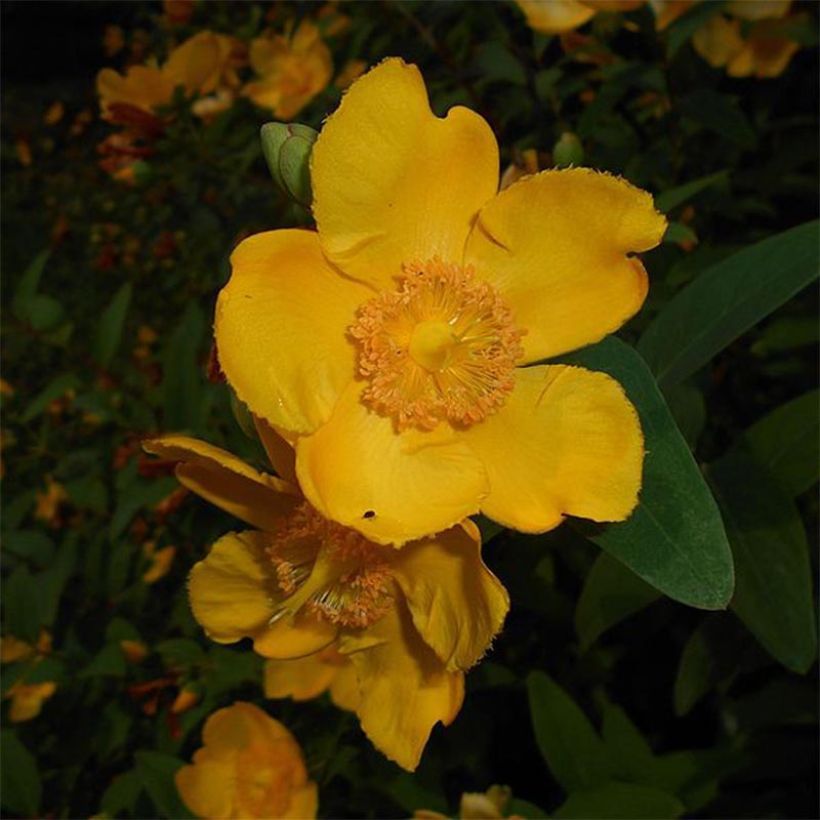



Plant habit
Flowering
Foliage
Botanical data
Hypericum
x moserianum
Clusiaceae
St. John's wort
Cultivar or hybrid
Other Hypericum - St.John's Wort
Planting and care
Plant in a sunny position in cool regions, or in partial shade, or even in shade in hot climates, sheltered from the wind. Its foliage can be damaged by excessive sun. It requires light, fairly deep soil, even poor and chalky, and above all well-drained as it fears moisture in winter. It is hardy down to -15°C (5°F). It is not very prone to diseases and its enemies are rare. Prune to shape it in late winter.
Planting period
Intended location
Care
-
, onOrder confirmed
Reply from on Promesse de fleurs
Summer-flowering shrubs
Haven't found what you were looking for?
Hardiness is the lowest winter temperature a plant can endure without suffering serious damage or even dying. However, hardiness is affected by location (a sheltered area, such as a patio), protection (winter cover) and soil type (hardiness is improved by well-drained soil).

Photo Sharing Terms & Conditions
In order to encourage gardeners to interact and share their experiences, Promesse de fleurs offers various media enabling content to be uploaded onto its Site - in particular via the ‘Photo sharing’ module.
The User agrees to refrain from:
- Posting any content that is illegal, prejudicial, insulting, racist, inciteful to hatred, revisionist, contrary to public decency, that infringes on privacy or on the privacy rights of third parties, in particular the publicity rights of persons and goods, intellectual property rights, or the right to privacy.
- Submitting content on behalf of a third party;
- Impersonate the identity of a third party and/or publish any personal information about a third party;
In general, the User undertakes to refrain from any unethical behaviour.
All Content (in particular text, comments, files, images, photos, videos, creative works, etc.), which may be subject to property or intellectual property rights, image or other private rights, shall remain the property of the User, subject to the limited rights granted by the terms of the licence granted by Promesse de fleurs as stated below. Users are at liberty to publish or not to publish such Content on the Site, notably via the ‘Photo Sharing’ facility, and accept that this Content shall be made public and freely accessible, notably on the Internet.
Users further acknowledge, undertake to have ,and guarantee that they hold all necessary rights and permissions to publish such material on the Site, in particular with regard to the legislation in force pertaining to any privacy, property, intellectual property, image, or contractual rights, or rights of any other nature. By publishing such Content on the Site, Users acknowledge accepting full liability as publishers of the Content within the meaning of the law, and grant Promesse de fleurs, free of charge, an inclusive, worldwide licence for the said Content for the entire duration of its publication, including all reproduction, representation, up/downloading, displaying, performing, transmission, and storage rights.
Users also grant permission for their name to be linked to the Content and accept that this link may not always be made available.
By engaging in posting material, Users consent to their Content becoming automatically accessible on the Internet, in particular on other sites and/or blogs and/or web pages of the Promesse de fleurs site, including in particular social pages and the Promesse de fleurs catalogue.
Users may secure the removal of entrusted content free of charge by issuing a simple request via our contact form.
The flowering period indicated on our website applies to countries and regions located in USDA zone 8 (France, the United Kingdom, Ireland, the Netherlands, etc.)
It will vary according to where you live:
- In zones 9 to 10 (Italy, Spain, Greece, etc.), flowering will occur about 2 to 4 weeks earlier.
- In zones 6 to 7 (Germany, Poland, Slovenia, and lower mountainous regions), flowering will be delayed by 2 to 3 weeks.
- In zone 5 (Central Europe, Scandinavia), blooming will be delayed by 3 to 5 weeks.
In temperate climates, pruning of spring-flowering shrubs (forsythia, spireas, etc.) should be done just after flowering.
Pruning of summer-flowering shrubs (Indian Lilac, Perovskia, etc.) can be done in winter or spring.
In cold regions as well as with frost-sensitive plants, avoid pruning too early when severe frosts may still occur.
The planting period indicated on our website applies to countries and regions located in USDA zone 8 (France, United Kingdom, Ireland, Netherlands).
It will vary according to where you live:
- In Mediterranean zones (Marseille, Madrid, Milan, etc.), autumn and winter are the best planting periods.
- In continental zones (Strasbourg, Munich, Vienna, etc.), delay planting by 2 to 3 weeks in spring and bring it forward by 2 to 4 weeks in autumn.
- In mountainous regions (the Alps, Pyrenees, Carpathians, etc.), it is best to plant in late spring (May-June) or late summer (August-September).
The harvesting period indicated on our website applies to countries and regions in USDA zone 8 (France, England, Ireland, the Netherlands).
In colder areas (Scandinavia, Poland, Austria...) fruit and vegetable harvests are likely to be delayed by 3-4 weeks.
In warmer areas (Italy, Spain, Greece, etc.), harvesting will probably take place earlier, depending on weather conditions.
The sowing periods indicated on our website apply to countries and regions within USDA Zone 8 (France, UK, Ireland, Netherlands).
In colder areas (Scandinavia, Poland, Austria...), delay any outdoor sowing by 3-4 weeks, or sow under glass.
In warmer climes (Italy, Spain, Greece, etc.), bring outdoor sowing forward by a few weeks.

































